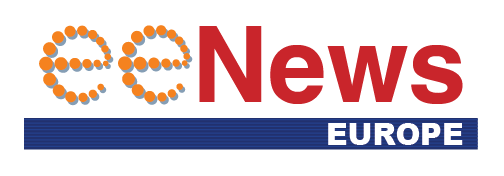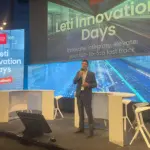
CEO interview: Build quantum on silicon says Equal1’s Lynch
Equal1 Labs Ltd. (Dublin, Ireland) is preparing to launch its UnityQ quantum computing chip in 2025. It will combine six electron-spin based qubits implemented in silicon along with ARM CPUs, NPUs and AI acceleration all operating at a temperature of about 500mK.
And CEO Jason Lynch is convinced that the key to his company’s success will be that its quantum computing is built on the ecosystem of the semiconductor industry and is able to be integrated either monolithically – or alongside it in chiplet form.
Equal1 Labs was founded in 2017 to commercialize on research into quantum confinement and computing based on electron charge and spin. That research has evolved and the academic base broadened. But the company is now focused on electron spin in single-electron transistors.
Lynch told eeNews Europe that over the six years of the company’s existence it has raised US$30 million in funding from such sources as Atlantic Bridge and the European Innovation Council. Most of that time and money has been spent in stealth more recently producing test chips and patenting IP, including implementations on standard foundry processes. The work includes electron-spin quantum on silicon-germanium and on the 22FDX fully-depleted silicon-on-insulator (FDSOI) process from Globalfoundries Inc. in Dresden, Germany.
“Quantum computing is a massive opportunity but it needs to leverage the trillions of dollars that have been spent creating the silicon ecosystem,” said Lynch. “Every step along the computational path has been enabled by silicon and CMOS, for example GPUs and AI. Which is why quantum computing should be building right at the chip or chiplet level,” said Lynch. “Others don’t talk about it because they can’t integrate. Integration is the key to introduction,” he added.
Coping with cooling
While Lynch’s argument for hybrid quantum and classical computing integrated on silicon semiconductor technology may be compelling, what about the need for temperatures close to absolute zero? These are needed to lengthen the coherence time to the order of tens of microseconds so that a reasonable number of calculations can be performed. Doesn’t that provide a major barrier to market entry?
Lynch states that some experimental quantum techniques do require temperatures down to tens of millikelvin but Equal1’s research is being tested at 1K. “That’s much easier,” he said. Lynch points out that cooling for semiconductor operation is already common in medical electronics. “Every MRI [magnetic resonance imaging] scanner uses a closed-cycle cryogenic to get down to 3K,” Lynch said.
In addition, classical computing is become so highly and densely integrated that pwer consumption and cooling is becoming an issue. Thermal design is now a primary concern whatever the technology. “We’ve got test chips with 6 qubits in labs,” said Lynch. “In mid-2025 we are looking to release our entry stage product,” he said.
The unit will be datacenter-ready and initially have a rack form factor of 22U but with a view to reducing that to 6U. It will have the UnityQ quantum hardware, compressor, cryocooler and vacuum pump maintaining a 500mK environment while consuming 2kW. The self-contained nature of the quantum computer that Equal1 plans to deliver will also suit on-premises operation. Lynch foresees early applications of quantum computing in pharmacological research and banking operations, where keeping data out of the cloud could be key.
Being rack-based allows for scaling using conventional technology while at the same time Lynch expects UnityQ quantum hardware to scale from 6 to 17 to 127 and up to 1,000 qubits.

Equal1’s commercial roadmap through to 2030. Source: Equal1 Labs.
Lynch reckons that to start doing meaningful work assemblies of 1,400 physical qubits – equivalent to 1,000 error-corrected logic qubits – are required. Lynch said he expects Equal1 to get there within 24 months. Ultimately a modular chiplet-style architecture can scale to tens of thousands of error-corrected logical qubits to create powerful and reliable quantum computers.
Meanwhile other companies are pursuing trapped-ion, trapped atom and photon-based quantum computing with greater or lesser cooling requirements. Lynch indicated the photonic quantum computing may be more suited to quantum communications and cryptography. “We don’t think there will be one winner here. There will be multiple [quantum] technologies.

A view of the quantum computing competitive landscape. Source: Equal1 Labs.
Equal1 Labs has 36 employees with offices in Dublin; Delft in the Netherlands; Timosoara, Romania; Sherbrooke, Canada; and San Carlos, Calif. And so the burn rate of the funding achieved so far is rising.
Lynch said that Equal1 is looking towards another funding round. When asked if it could match some of the scale-up rounds enjoyed by other quantum computing, such as PsiQuantum Corp. (Palo Alto, Calif.) Lynch said, “It is not necessarily about raising hundreds of millions of dollars. It is about the correct use of the right level of investment.”
Related links and articles:
News articles:
PsiQuantum raises US$600 million for first hyperscale quantum computer
Australia’s quantum IC startup Diraq adds funds for US launch
Pasqal assembles 1,000 trapped atoms for quantum computing
Germany’s first hybrid quantum computer opens with IQM
 If you enjoyed this article, you will like the following ones: don't miss them by subscribing to :
eeNews on Google News
If you enjoyed this article, you will like the following ones: don't miss them by subscribing to :
eeNews on Google News








